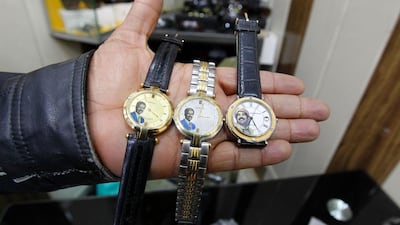BAGHDAD // Shopkeeper Anwar sells Saddam Hussein photos, coins and postage stamps that keep the former president alive 10 years after his execution and cater to customers nostalgic for his rule.
While Saddam was brutal to those who opposed him, and led his country into two disastrous wars, there are those who still look back fondly on his time in power, especially in comparison to the years of devastating internal violence and ineffective governance that followed his overthrow in 2003.
In his antique shop, Anwar proudly caresses a leather holster stamped with the words: “On behalf of President Saddam Hussein.”
“It was a gift that Saddam gave to deserving officers,” said Anwar, a young man who may be his own best customer for Saddam memorabilia.
“I am constantly looking for items related to Saddam, but when I find them, I often keep them for myself.”
Offering a line of reasoning often used to support the ex-president, Anwar, who mainly trades in more innocuous, non-political items, said: “Saddam Hussein knew how to control the country.”
“And I say this as a son of the south,” he added, indicating that he is a member of Iraq’s Shiite majority, which was the target – along with Iraqi Kurds – of deadly oppression under Saddam’s rule.
In a macabre twist of irony, Saddam was hanged inside one of his own regime’s former torture centres a decade ago on December 30, 2006.
The centre was located in the military intelligence headquarters in the Kadhimiyah district of northern Baghdad.
Officials who witnessed the predawn execution say Saddam, 69, remained defiant to the end, railing against his Iranian and American enemies and praising insurgents who had pushed Iraq to the brink of civil war.
__________________________________
ISIL in Iraq
■ In secret phone calls, Mosul residents tell of being afraid to leave their homes
__________________________________
“I didn’t see any signs of fear,” then national security adviser Mowaffak Al Rubaie, who oversaw the execution, said in 2013.
“I didn’t hear any regret from him, I didn’t hear any request for mercy from God ... or request for pardon.”
Mr Al Rubaie said he pulled the lever to hang Saddam, but it did not work. An unidentified person then pulled it a second time, killing him.
The former strongman was executed after being found guilty of crimes against humanity for the 1982 killing of 148 Shiites in the town of Dujail. The massacre followed an assassination attempt against him there.
The day after his death, Saddam was buried in the village of Awja, his birthplace near Tikrit, 160 kilometres north of Baghdad.
It was also near Tikrit, just over three years before on December 13, 2003, that Saddam was captured by US forces. Washington had offered a US$25 million (Dh91.8m) reward for his capture.
After being overthrown by the US-led invasion, Saddam was on the run for eight months with the help of bodyguards from his family, according to local tribal leaders.
But one betrayed him, leading American troops to Saddam’s hiding place after himself being detained.
Far from the luxury of his presidential palaces, Saddam was found hiding on a farm down what American troops called a “rathole”, an underground hideout with enough space for a person to lie down in, equipped with an air vent and an exhaust fan.
As he peered out from his den, he announced in English: “I am the president of Iraq and I want to negotiate,” US army officers said.
The 1982 killings in Dujail was “the day of the end of the head of the snake that reduced Iraqis to the rank of humiliated citizens”, says Khalaf Abdulsamad, a lawmaker from the Shiite Dawa party which has held the Iraqi premiership since 2006.
Saddam countered dissent with prison, torture and death, started a disastrous 1980-1988 war with Iran, and invaded Kuwait in 1990, leading to years of punishing sanctions.
But his rule also offered stability, quality education, health care, employment and services for most of the population – commodities that have often been in short supply in the years since his fall.
The 2003 US-led invasion of Iraq unleashed years of sectarian violence, including frequent bombings, kidnappings and executions that peaked from 2006-2008.
That violence was sharply reduced by the combination of Sunni Arab tribesmen joining forces with American troops, and the US military’s “surge” of additional forces in Iraq.
But it was not to last: violence steadily rose in the years after the US military withdrew in 2011, driven in large part by widespread anger among Sunni Arabs with then-prime minister Nouri Al Maliki’s government.
Mr Al Maliki’s heavy-handed response to anti-government protests led to the government losing control of one entire city and shifting parts of a second in early 2014.
Six months later, ISIL launched a sweeping offensive across territory north and west of Baghdad, overrunning large swathes.
Iraqi forces have pushed the extremists back, but doing so has devastated Sunni Arab cities and towns, laying the groundwork for further discontent and conflict.
In Anwar’s shop, Ilaf, a law studen, criticised both Iraq’s past and present leadership.
“Saddam Hussein was an enormous serpent,” he said.
“Today, it is a multitude of small serpents that lead us.”
* Agence France-Presse

